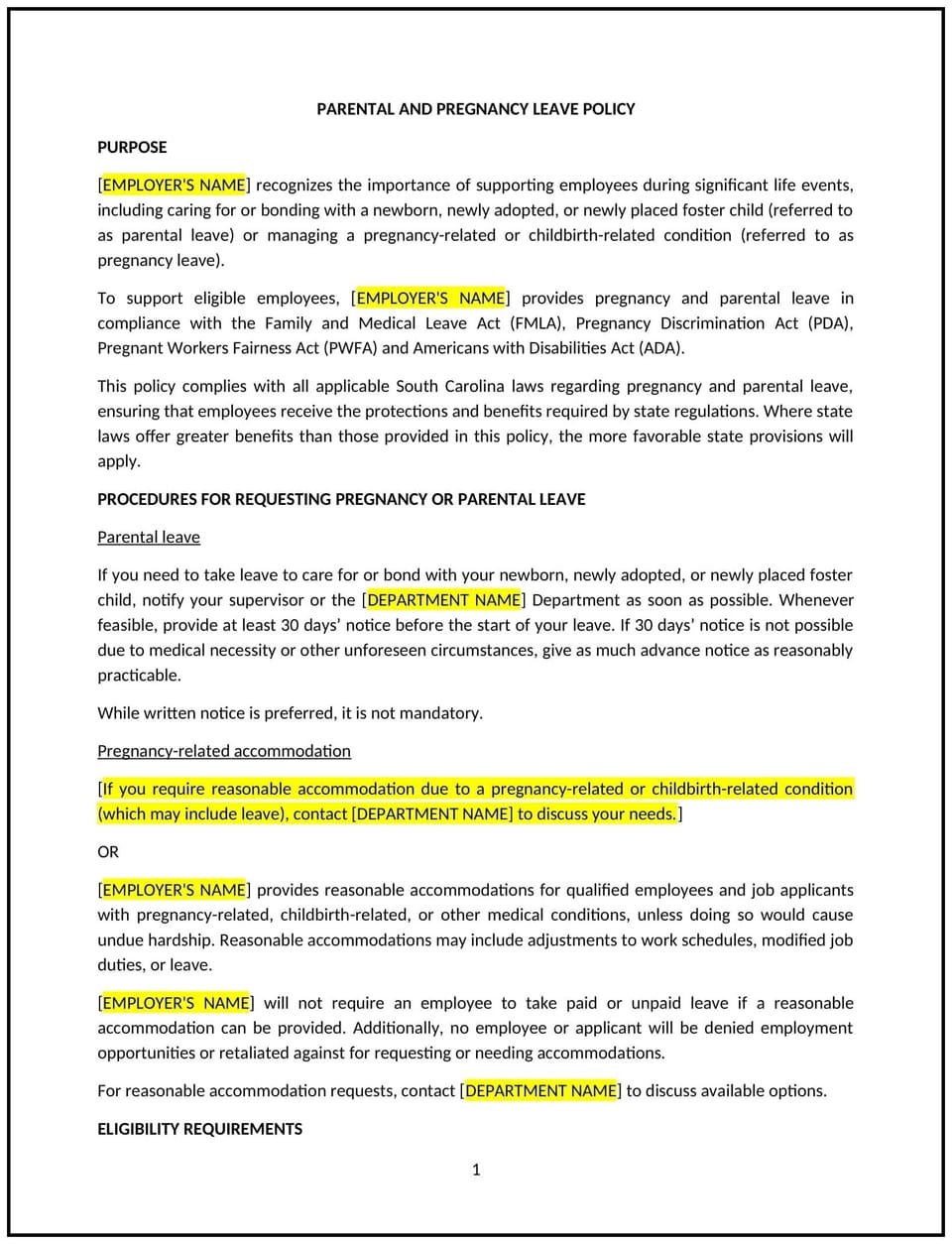Parental and pregnancy leave policy (South Carolina): Free template

Parental and pregnancy leave policy (South Carolina)
This parental and pregnancy leave policy is designed to help South Carolina businesses establish guidelines for employees taking leave for childbirth, adoption, or pregnancy-related medical needs. It outlines procedures for requesting leave, maintaining job protection, and complying with federal and state laws, such as the Family and Medical Leave Act (FMLA).
By adopting this policy, businesses can support employees during significant life events, ensure compliance with legal requirements, and foster a positive work environment.
How to use this parental and pregnancy leave policy (South Carolina)
- Define leave types: Explain what constitutes parental leave (e.g., childbirth, adoption) and pregnancy-related medical leave.
- Establish eligibility criteria: Specify which employees are eligible for leave, such as those who have worked for a certain period or meet hours-worked requirements.
- Set request procedures: Provide steps for employees to request leave, including required notice and documentation.
- Address job protection: Guarantee that employees will return to the same or an equivalent position after completing leave.
- Train managers: Educate supervisors on handling leave requests and maintaining workflow during employee absences.
- Review and update: Assess the policy annually to ensure it aligns with evolving legal standards and business needs.
Benefits of using this parental and pregnancy leave policy (South Carolina)
This policy offers several advantages for South Carolina businesses:
- Supports employee well-being: Demonstrates a commitment to helping employees balance work and family responsibilities.
- Aligns with legal standards: Helps businesses comply with federal and state leave laws, such as FMLA.
- Builds employee loyalty: Shows employees that the business values their personal and family needs.
- Reduces turnover: Encourages employees to return to work after leave, reducing recruitment and training costs.
- Enhances reputation: Demonstrates a commitment to employee care and work-life balance.
Tips for using this parental and pregnancy leave policy (South Carolina)
- Communicate the policy: Share the policy with employees and include it in the employee handbook.
- Provide training: Educate managers on handling leave requests and maintaining workflow during employee absences.
- Monitor adherence: Regularly review leave requests to ensure they are addressed promptly and fairly.
- Address issues promptly: Take corrective action if leave requests are mishandled or denied improperly.
- Update regularly: Assess the policy annually to ensure it aligns with evolving legal standards and business needs.
Q: How does this policy benefit businesses?
A: This policy supports employee well-being, aligns with legal standards, and builds employee loyalty by providing clear guidelines for parental and pregnancy leave.
Q: What types of leave are covered under this policy?
A: Leave may include childbirth, adoption, or pregnancy-related medical needs.
Q: How can employees request parental or pregnancy leave?
A: Employees should follow the request procedures outlined in the policy, including providing required notice and documentation.
Q: Are part-time employees eligible for parental or pregnancy leave?
A: Eligibility depends on hours worked and tenure, as outlined in the policy and applicable laws.
Q: How often should businesses review this policy?
A: Businesses should review the policy annually or as needed to ensure it aligns with evolving legal standards and business needs.
This article contains general legal information and does not contain legal advice. Cobrief is not a law firm or a substitute for an attorney or law firm. The law is complex and changes often. For legal advice, please ask a lawyer.


